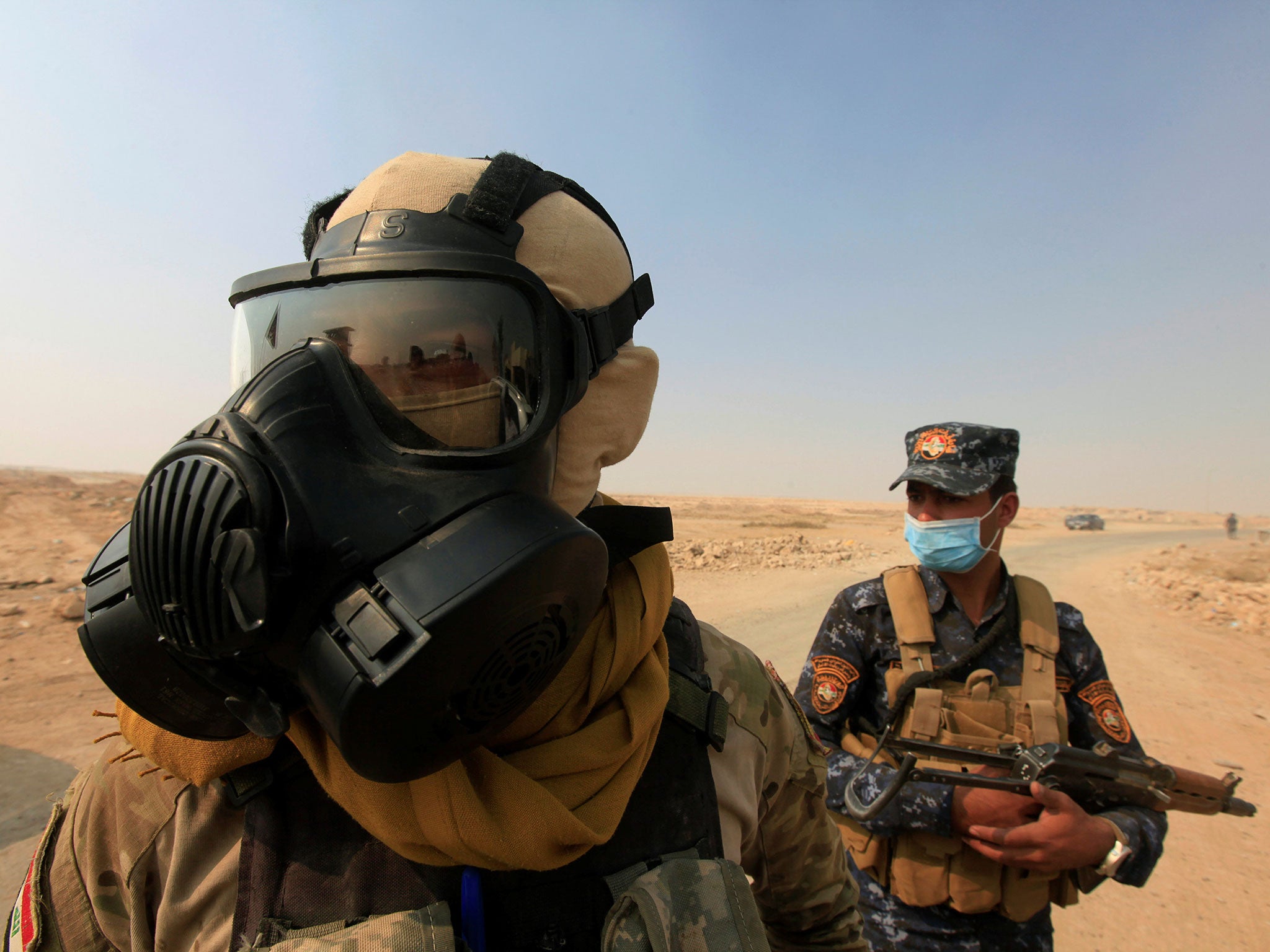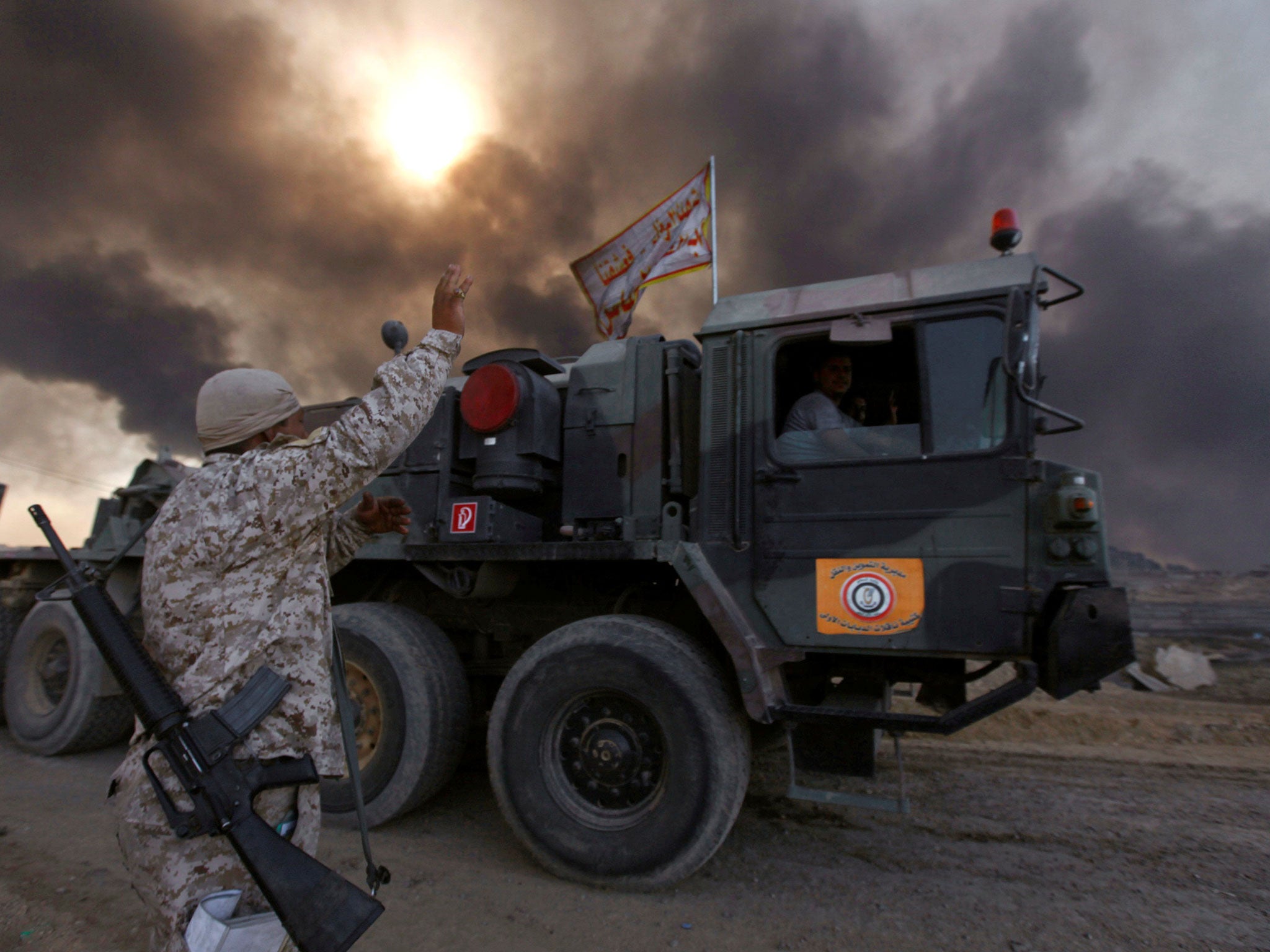Mosul offensive: 'Civilians killed' by toxic sulphur fumes after Isis sets factory on fire to slow Iraqi advance
Iraqi journalist shot dead while covering advance to south of city

Your support helps us to tell the story
From reproductive rights to climate change to Big Tech, The Independent is on the ground when the story is developing. Whether it's investigating the financials of Elon Musk's pro-Trump PAC or producing our latest documentary, 'The A Word', which shines a light on the American women fighting for reproductive rights, we know how important it is to parse out the facts from the messaging.
At such a critical moment in US history, we need reporters on the ground. Your donation allows us to keep sending journalists to speak to both sides of the story.
The Independent is trusted by Americans across the entire political spectrum. And unlike many other quality news outlets, we choose not to lock Americans out of our reporting and analysis with paywalls. We believe quality journalism should be available to everyone, paid for by those who can afford it.
Your support makes all the difference.Isis fighters have set sulphur stockpiles on fire, killing civilians with toxic gas and forcing Iraqi and American troops to wear masks as the group attempts to slow the advance on Mosul.
The region around the Mishraq Sulphur Plant was covered with yellowish fumes on Saturday, as battles continued surrounding the militants’ last major stronghold in Iraq.
“Daesh (Isis) blew up the sulphur plant two days ago and that has led to the deaths of two people among the civilians in nearby villages,” General Qusay Hamid Kadhem told the AFP news agency. “Of course, this is affecting our planned progress.”
Many others were injured by the fumes, with US troops at a base to the south in Qayyarah, the site of the Q-West Airfield, wearing gas masks as a precaution.
The blaze was expected to burn for days, with a fire started at the same factory in 2003 burning for almost a month and causing the largest recorded man-made release of sulphur dioxide in smog that could be seen from space.
It came as Iraqi security forces, the Kurdish Peshmerga and militias continued their advance on Mosul, pushing into Qaraqosh.
The Iraqi army’s 9th Division raised the national flag over a central government stronghold in the Christian town, also known as Hamdaniyah or Bakhdida, which has been mostly deserted since Isis’ advance in 2014.
It lies 12 miles from Mosul, with roads and settlements leading towards the city laden with improvised explosive devices, Isis snipers, booby traps and suicide bombs. Iraqi forces also came under fire in the town of Bartella, which was retaken last week.
Isis’ Amaq agency claimed jihadis had foiled an attack on Qaraqosh and seized weapons left by retreating Shia militias as its propaganda sought to play down mounting losses in the offensive. The claims could not be verified.
An Iraqi journalist was killed while covering military operations to the south of Mosul as battles continued on Saturday.
Alsumaria TV said Ali Risan, a cameraman, was shot in the chest by an Isis sniper in the al-Shura area. News of his death came a day after another journalist, Ahmet Haceroglu of Turkmeneli TV, was shot dead by militants while covering the Isis assault on Kirkuk.
Fighting continued in the city on Saturday after Isis launched a series of bloody attacks in what officials described as an attempted diversion from the Mosul offensive. Fighters killed more than a dozen workers at a power plant and attacked provincial headquarters in the Kurdish-controlled city, 100 miles to the south east of its de-facto Iraqi capital.
Colonel Redah Sheikh said skirmishes continued between Peshmerga troops and Isis fighters in some districts on Saturday but the situation was contained.
Gory photos posted on social media showed the bodies of captured Isis militants killed by hanging or being crushed by breezeblocks, with corpses dumped in bins and dragged through the streets by cars.
Zeid Ra’ad al-Hussein, the UN high commissioner for human rights, called for all forces active in Iraq to abide by international law on Friday.
“Isil [Isis] fighters who have been captured or have surrendered should be held accountable in accordance with the law for any crimes they have committed,” he added.

The UN has concern for around 1.5 million civilians believed to be trapped inside Mosul, with at least 550 families forced from surrounding villages to be used as human shields in recent days.
Humanitarian organisations say there is also inadequate provision for thousands of civilians displaced by the advance, which is expected to become the biggest battle in Iraq since the 2003 invasion.
The assault has been hailed as decisive by commanders in Iraq and the US but analysts have warned the battle is likely to take months, with jihadis likely to flee into Isis territory in neighbouring Syria to regroup.
Renad Mansour, an academy associate of the Middle East and North Africa programme at Chatham House, told The Independent the loss of Mosul was certain but would “definitely not” signal the end of Isis. He predicted Isis would revert to guerrilla-style warfare in Iraq, while leaders form a new strategy to continue attempts to build the group’s “caliphate”.
“They will come together and wait – they know there’s no political solution, as well as fear of Kurdish Peshmerga and militias,” he added. “They know at some point the ground will be ripe again for them to move back in. Everyone is still looking short term, at a military solution for Mosul rather than the future of Isis.”
Ash Carter, the US defence secretary, has arrived in Baghdad on an unannounced visit to meet Iraqi commanders as the US-led coalition continues air strikes in support of advancing troops. He arrived two days after an American service member was killed outside Mosul in the fourth combat death for the country’s forces since it started anti-Isis operations in August 2014.
British troops are also involved in the offensive, with special forces reportedly fighting alongside Irqi security forces and the Kurdish Peshmerga.
Additional reporting by agencies
Join our commenting forum
Join thought-provoking conversations, follow other Independent readers and see their replies
Comments